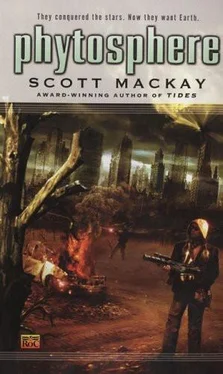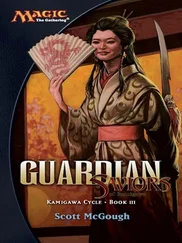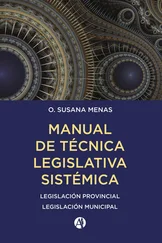Smallmouth 3 performed a complete survey of Gaspra, correlating the new topographical information to the known engineering tolerances of the five FMC Transit Collective drives, and feeding all this into a computer program that was meant to design, out of the misshapen rock that was Gaspra, the best possible spacecraft and, more importantly, the best possible planet killer. The program established five installation areas—these would be the five primary thrust bays, and operationally would be connected via laser through the PCV’s thrust conduits.
The crew sledded the drives one at a time to their installation areas, riding the sled two hundred yards above Gaspra’s surface. It was a bit like maneuvering an old-time zeppelin, as it had to be done with great care. The dual dangers were either that the drive would slam into the surface of the asteroid, or, barring that, would drift away into outer space. It had to be maneuvered through what Ian kept calling, with some nervousness, the “critical plane.”
Despite the finickiness involved, they managed, over the coming days, to anchor the drives into the installation areas with glitchless monotony. Gerry’s confidence climbed each time a new drive was installed. This was vindication. This was proof that he could do something like this. This told him that he was more than just Neil Thorndike’s younger brother.
Their third day, they sledded Drive Four to its installation area, what they were dubbing the Norbert Plains, after Mitch’s partner back on Earth. In fact, all the installation areas were plains of one type or another—the computer program had minimized the landform-thrust interference ratio as much as possible.
They maneuvered Drive Four over the selected area, then allowed the sled’s ion pump to give it a shove groundward. The crew capitalized on this downward momentum and soon had their boot crampons biting into the asteroid’s surface. Except for some minor irregularities, the surface was flat and devoid of loose particulate.
The stars swept by overhead as the short day counted out its two hundred and nine minutes. The three of them, like superheroes, held the drive above their heads, a unit that was fully the size of ten transport trucks but weighed next to nothing in Gaspra’s weak pull.
Ian said, “Let’s shift it a few yards to the left. We’ll miss that swell over there.”
So they moved it a few yards to the left, like three guys moving a big couch.
“Settle her down,” said Ian.
Which they did.
The mission continued with seamless predictability until Mitch started working on anchor seventeen.
Then Gerry heard through his helmet radio the two most dreaded words any crew never wanted to hear during a space mission.
“Oh, shit.”
Mitch drifted upward from Drive Four at a speed greater than escape velocity. His crampons had failed, and the force of his pneumatic drill had propelled him into space like one of the old Atlas rockets, his trajectory on an angle so that he didn’t drift straight up but floated quickly over the short horizon like a stray cloud. Ian fired a line to him, but by that time it was too late. Gerry keyed over to Mitch’s visor readouts and saw that the diminutive engineer had red lights not on one, but on both crampons. One he could accept. Two was…well, suspicious. Then both Ian and Gerry cramponed over to the sled. Ian interfaced the sled’s computer with Mitch’s CAPS computer to see if the two could arrive at a workable procedure. By this time, Mitch was well out of view beyond the short horizon.
“Mitch?” said Gerry.
“Jesus Christ…oh, shit! Where are you guys?”
Gerry and Ian looked at each other. It was Ian who delivered the bad news. “Mitch…the sled is giving us a negative on a rescue mission.”
“What? Are you sure?”
“Affirmative.”
“But that’s impossible. The sled should have more than enough thrust to reach me. I can’t be more than three miles away. Why’s it giving you a negative?”
Ian hesitated. “Because I’m afraid that the particular code needed to effect the proper burns and trajectories…it’s gone. Deleted. Not by me.”
The silence that came to the three of them was like the turning of a page. Gerry felt a tightening in his throat, and the tightness quickly spread to his stomach as the claw of an overwhelming apprehension closed its grip. He heard Ian’s voice through his suit radio, a few tense words, “What happened, Mitch?”
but the words seemed to come to Gerry through thick cotton batting.
“Both my crampons red-lighted at the same time,” said Mitch. “Do you know what the likelihood of that is?”
Mitch’s voice sounded hurt. Ian responded, telling the technician, “Even in my day we never got two red lights at the same time….” His words seemed unsure, as if the idea expressed was one Ian never expected to find in his mouth, especially in the current context. “And with the rescue software kaput… I don’t know. What are the chances?”
All the while Gerry felt Mitch was on a big river, and that he was getting further and further away. His face tensed into a mask of anxiety; he liked Mitch, and couldn’t believe they might lose him.
“Around one in twenty-five million,” said Mitch, because Mitch was always a man for statistics. Gerry heard the AviOrbit technician’s breath coming and going quickly. “It’s them,” he said, his voice going lower, dipping, like hanging onto the edge of a cliff and finally letting go. “They’ve done something.” Then a pause, accompanied by a little rough static from the radio. “You guys need redundancy procedures.”
Mitch might have spoken a foreign language. Redundancy procedures? Gerry was nonplussed. The man was going to die . “Mitch, just hang on. We’re going to save you.”
“That’s it.” Ian had gone into reckless mode, the damn-the-torpedoes Hamilton of old. “I’m getting on the sled. Just hang on, little guy. I’ll be there in a minute.”
“No! Listen to me! The two of you! My suit tells me I’ve broken orbit. There’s nothing you can do. If the rescue software is deleted, that’s…” Then, softer: “That’s it. Let’s face it, the delete is another Tarsalan trick. Ian, if you come after me in the sled, that’s two of us gone. You’re at work, Ian.
Remember? The first job you’ve had in five years. Let’s stay professional. Gerry?”
Gerry felt miserable, but managed to get the words out. “I’m here, Mitch.”
“Have you confirmed the delete? Let’s stick to procedure. Can you confirm?”
“It’s a no go on all fronts.”
“Then that’s it. There’s nothing we can do.”
“I’m sorry, Mitch.”
“I’ve got eighteen hours of life support.”
“Mitch, we could still…” This from Ian, but the words came out in the defeated tone of a man who had reached that cusp where hope and hopelessness merge, and, balancing for an instance on the possibility of last-ditch efforts, the pilot finally teetered into the territory of lost causes. He gave the console a petulant smack with a half-closed fist and turned to Gerry. He shook his head.
“There’s nothing we can do?” asked Gerry.
“There’s zero chance of getting him back, and we risk the whole mission if we try.”
Through his yellow-tinted visor, Gerry discerned his old friend’s face. Here they were again; not the first time they’d been in extreme circumstances—though riding an asteroid bronco-style while a friend drifted to his death was perhaps the most extreme circumstance of all. Ian’s lips had a curious curl, and his eyes had narrowed with resentment. Gerry, on the other hand, felt shocked into a kind of mild catatonia.
Mitch had guts of steel, though, because he was already on to the next thing, miles ahead of either of them. “There’s only two of you now.”
Читать дальше












